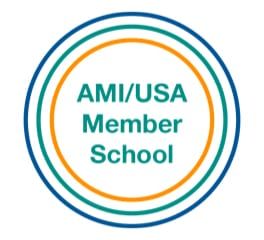Classroom Notes | February 2019
Ms. Hunt
Chinese New Year
Happy New Year!…Chinese New Year, that is! Our classroom started off this month by celebrating the Spring Festival, or Lunar New Year, on February 5th. This festival is celebrated primarily on the continent of Asia, and also by people who have moved from that region to other parts of the world. Ms. Liang is one of those people, and she graciously shared stories, customs and artifacts from her native China. We decorated our classroom with colorful lanterns of red and gold (symbolizing good fortune and health), viewed clothing worn by children for the festival (new clothing is purchased every year before the festival begins), examined intricate and delicate paper cuttings from China (a specialized art form hung in windows), and even received a gift of Chinese currency in a red envelope (typically given by family elders to young children during the New Year). It was an exciting week and we thank Ms. Liang for sharing her knowledge with us!
Our Valentine’s Day
Children learned several songs to coincide with Valentine’s Day, including “Bring Me a Rose”, “Magic Penny”, and “Make New Friends”. The subtle appearance of hearts (both anatomical and hand drawn) in our paper cutting work also marked the holiday, with many children then using these papers in our collage work. Children shared their homemade valentines with the class, and we hung them in the classroom for everyone to enjoy… “Love it something if you give it away, you end up having more”.
Grace and Courtesy
Our daily Grace and Courtesy lessons have responded to the uptick of sickness present in the school in the past month. We have been practicing how to effectively blow your nose, let another person know they might need a tissue, to thoroughly wash hands, and why keeping your germs with your body helps keep others safe. These lessons not only keep our community healthy, they also support the independence and self care of each child. Practicing these skills at home will build your child’s self awareness and pride in caring for themselves (and may help keep sickness at bay!).
We’re Sewing!
Our sewing shelf has captured the children’s attention! Each child begins with basic burlap sewing, learning how to thread a needle and develop their fine motor skills through the running stitch. Button sewing builds upon these skills as the child learns how to tie an end knot and securely attach a button. Embroidery expands these skills into the aesthetic realm, as the child creates their own design to embroider using different embroidery stitches (the satin stitch is an exciting addition!). When a child has two complete pieces of embroidery, they can make a pillow, using the whip stitch to hold it all together. Sewing activities are based upon the children’s interest and level of skill, and grow in length and complexity during the child’s three years at the Primary level. What starts as purely development of mechanical skills (burlap sewing) grows into skills for independence (button sewing) and moves toward an aesthetic art form (embroidery, pillow making and beyond).
Thank you to those that were able to come to the Chili Cook-Off this year! This always proves to be a fun and delicious way to connect with our community, and we extend our gratitude to those that make the event possible each year!
Ms. Thome
February was a time to celebrate the people we hold dear to our hearts. We all shared ideas about how to spread that love throughout all the days of the year. Valentine’s Day is a wonderful time to focus on what it means to serve others. We broaden our sense of a loving community by sharing a meal together, pouring tea, arranging flowers, and even greeting guests. All of these lessons help children develop compassion and empathy for others.
Songs this month! “Love is something if you give it away, you end up having more” and “Back in your own back yard” – You’ll find your happiness lies, right under your eyes…back in your own back yard. The children love these songs.
From an outsiders perspective the Sensorial Area in a Montessori classroom might seem simple or just fun, but the importance of sensory stimulation and education cannot be underestimated. We know that from birth and even before the child has come into the classroom he has had thousands of sensory experiences and that has directly influenced the child’s mental development, processing skills, imagination, higher order of thinking, unconscious absorption, concrete manipulation, and sensorial exploration.
The Sensorial Area especially fulfills the child’s human tendencies for exploration, experimentation, order, and pattern seeking. However the other tendencies are not left behind; activity, exactness, imagination, concentration, orientation, and self development are stimulated and fulfilled. If we are to give the children the keys to the world we must bring the world into the classroom. Our world if full of objects that have color, shape, volume, size, texture, weight, sound, smell.
The Sensorial materials are designed to help children become aware of the relationships of things, between and among. We do this through activities like pairing, sorting, matching, and grading.
We help children grasp the qualities of the world and then begin to offer essential facts. I believe that by helping children explore the world sensorially they become more observant and this creates a more intimate connection with all things. It can spark curiosity about simple things and children end up surprised with feelings of love and satisfaction.
Ms. Crews
Professional Development
This month the FCMS guides travelled to New Orleans , where we attended a the annual AMI Refresher Course ; a two day seminar where Montessorians gather from around the United States to deepen their knowledge of pedagogy and build community. We also enjoyed the sights, sounds, and tastes of the city and strengthened friendships new and old.
My biggest takeway? That I am so grateful to be a part of an authentic Montessori school with guides who are committed to honing their craft, serving the children, and supporting one another.
We also got to hear some great theory and new ideas from our Primary trainer and the current head of pedagogy for AMI, Ginni Sackett.
It was a lovely experience. Thanks to all of those who made it possible.
Fun with Grammar
When a child begins reading in the Primary classroom, a whole new way of exploring the classroom opens up to her.
One of the ways we play with reading is introducing parts of speech with the Grammar Symbols . We introduce the concept that words have different functions in a sentence. We have colorful symbols for highlighting each of these words. The Farm acts as a classification from which children can bring objects, almost like a scavenger hunt. This month I also showed the oldest children that they could write their own labels and bring anything they could write, and the game took off.
Here are some recent grammar games:
The blue triangle is for words that describe : adjectival phrases tell a child which specific animal to bring from the farm. “The brown horse.” “The jumping lamb.”
The pink symbol is for words that join. The word ‘and’ joins words together the same way the pink yarn joins the objects together.
The red circle represents words that we can do rather than things we bring. Each card is an action you can read and do or have a friend do! And when Montessori children run out of symbols, they get resourceful and decide to make more , of course!
Last week we played by writing our own labels for the Geometry Cabinet (part of the Sensorial area), and brought increasingly smaller rectangles. “No, that’s still not the rectangle I was thinking of….!”
Yesterday we wrote labels for various Sensorial materials around the room. What a blast! It was a great way to bring alive the Sensorial area with Language, and the children find it hilarious. I have to continually write adjectival labels that will further describe exactly what I’m thinking of. “You brought ‘the cylinder!’ But, it still isn’t the cylinder I was thinking of. I’m going to need to be more specific…”
After I left, the children continued by writing their own labels for one another to bring.
Observation
As Montessori guides we undergo extensive training in observing , which often takes great effort because it is different from the way we were originally taught to interact with children.
To press our lips together when we want to insert an opinion ,
To hold our hands still when we want to unecessarily help ,
To hold our excitement back when a child makes a discovery, and allow the discovery to be entirely his alone,
To hold our reaction when a glass object shatters, to prevent shaming the child and to allow for an empowering, teachable moment in cleaning up.
It can be difficult and counter to what society teaches us about being with children, but observing allows us to witness everyday miracles and learn how to adapt the environment to best serve the developing child.
I encourage you this month to be an observer of your child. To see him or her in a different light. What is he interested in? What makes her light up? How does he meet his needs? Is she able to meet her needs? What are the obstacles to this child being independent and thriving in this environment? Stepping back can prevent us from being an obstacle or an added distraction to their already busy minds. When we fight the urge to entertain or solve problems, children are free to come up with their own solutions and ideas. Then the magic begins.
Here are some lovely things I observed these past weeks:
- A 6-year old boy walking up to a box of addition equations and giving it a kiss, saying “hello, my friend!”
- A 6-year old girl giving a Sandpaper Letter lesson to a 4 year old girl, patiently demonstrating how to trace the letter and sending her back for the next one the same way she had learned when she was younger.
- A 3-year old scrubbing the same table for nearly an hour .
- A 6-year old boy helping a younger child fall asleep on her mat, and watching her face carefully for signs that she wasn’t going to wake before he tiptoed away.
- A child watching our fish closely until she commented: “I can see his gills moving in and out! I can see him breathing!”
My assistant captured this discovery on camera last week. We would never present these two materials (from the Math and Sensorial areas) together, but this child, given the time and space to wander the classroom, made this very interesting and spontaneous discovery. This child has had extensive experience with the Cylinder Blocks . He has taken them out and returned them multiple times, sometimes with a blindfold, and has also recently begun using the early Math materials for counting quantities 1-10. In this moment, he made a connection between the two experiences and brought them together. There are ten cylinders in each block, and the cylinders are in a gradation from largest to smallest! Here he is using his understanding of the numerals 1-10 to symbolize his experience of quantity and gradation.
Wonderful things happen when we stop fearing boredom and become observers of children.
Sign up to observe in your child’s classroom, if you haven’t already, and see what magic happens when you try this in your own home.
Thank you all for another lovely month in this community!
Ms. Schiller
We had another Going Out this month. A couple of the children arranged for a chaperone to drive them to the library and pick up a book that they had put on hold. I wish I could describe to you their exuberant energy upon their return. Their pride and feelings of success were so clear and true.
A Visit from OtterBox
This past month we had some guest volunteers from OtterBox come and spend some time in the classroom. They began by supporting us by deep-cleaning of some of our classroom materials. We then discovered that we had a 3D artist, a software developer, and a customer service representative (who used to be an attorney and the mayor of Castle Rock) in our midst. With that knowledge the volunteers offered to talk to the children about their work. The children enjoyed asking questions and seeing some of the 3D design work. It was so interesting to hear the thoughtful questions that the children asked. One of the volunteers remarked afterwards at how they were such a “curious, engaged, and courteous group”.
The Timeline of Life
The Timeline of Life is a material in the classroom that has been seeing a lot of use as of late. It is a timeline that represents life on Earth from the Cambrian Period (around 541 million year ago) up to the time that the human beings first made their appearance on Earth, the Quaternary Period, (around 190,000 years ago). The children are quite drawn to this material, as it has many curious creatures, it incorporates many stories, and engages thoughts about how life progresses over time. The timeline gives an opportunity for the children to look at life from a panoramic perspective, from the perspective of one era or one period at a time, from the perspective of one creature, or from the perspective of one concept/pattern that they follow throughout the entire timeline (looking at the development of teeth, for instance).
During President’s Day weekend, I attended a Montessori conference where we delved more deeply into the Timeline of Life and the Timeline of Human Beings. It was incredibly inspiring. I am now teaching the first of many songs that I learned at that conference, “The Trilobite Song”. It is such a delight to sing with the children each day.
Ms. Arminio
February was filled with visitors, projects and new lessons.
We worked diligently on our short story anthology, and it goes to the publisher March 15, 2019. We sent the proof for preview today.
We celebrated Chinese New Year. We continue to learn to read and write Chinese. Ms. Jones helps us perfect our skills.
We said goodbye to Ye Fu, Ms. Fu, who came to our classroom on February 1, 2019. Ms. Fu is from Zhejiang, China. She is taking her Montessori training in Milwaukee, USA. She will graduate with her AMI Elementary diploma in August, 2019. As a teacher in training, Ms. Fu gave many lessons, worked with the students individually, practiced classroom management, and celebrated Chinese New Year with us. We were sad to see her go, but happy that we shared this wonderful opportunity with her.
We celebrated February 14th, creating watercolor/collage love notes for our families and friends.
Colorado State University came to our school for a presentation about Atmospheric Science. The focus was on severe weather, weather basics, and climate. There were many awesome demonstrations.
Mr. Deery
Seeing the Big Picture
“Can you please share your perspective?” This question was raised by a girl during our classroom meeting on Friday afternoon. It was addressed to some of the boys in the classroom because some girls had become confused with some of the boys’ behaviors. In particular some girls were finding that when they would sit next to some of the boys in the classroom the boys would gather their things, stand up, and move. The girls initially came to me with the problem so I directed them towards the meeting agenda. After some discussion on the topic at meeting on Friday, one of the girls asked for the boys’ perspective.
The girls quickly discovered why the boys were moving and by the look on some of the girls’ faces, I could tell that some of the information shared by the boys wasn’t what they were expecting to hear. For example, one of the boys said, “You talk a lot when we sit with you.” While another said, “You once tried to get my attention by stabbing my hand with a pencil! I’d be crazy to sit next to you”. After the boys shared their perspective, one of the boys asked the girls, “Can you please share your perspective?” Unfortunately I can’t share what the girls said because that discussion is being saved for this week but what I’m really excited about is that the children are asking for each other’s perspective. Once they understand each other’s position, a resolution is never too far away.
Seeing the big picture isn’t only something we strive for in classroom meetings. The children are also coached to see the big picture when writing essays. As the children are making their outlines, they develop content for their essays by asking themselves questions such as, What are the problems with this idea? What are some solutions to this problem? What are the best arguments for my position? And what are the best arguments against my position? With each other’s help, the children gain a full perspective of their topic and can write thoughtful responses to their essay questions and gain valuable thinking skills for life.
Some Feedback from a Guest Speaker
Chris, so sorry for running over my allotted time … I should have asked if the class had a “hard” stop. I have never had so many questions from any group, let alone a group of elementary school students. My goal, besides answering questions, was to pique the interest of the kids. Despite running (way) over, I hope you considered it a reasonable use of their time.Thanks for the opportunity to discuss astronomy stuff with the classes. As I mentioned, if there are more questions, please have their parents (or you) contact me.
Best regards,
Greg
The children were delighted to have Greg Haloc from the Northern Colorado Astronomical Society visit the upper elementary classroom. Some of children’s favorite experiences were when Greg used a 40 inch by 2 inch piece of paper to show the relative position of the planets in the solar system, learning how the earth looks from the moon, and learning some of the reasons why the moon has so many visible craters compared to earth. We definitely want to have Greg back again sometime soon.
The post Classroom Notes | February 2019 appeared first on Fort Collins Montessori School.


























